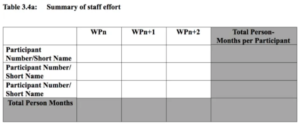You are (hopefully) quite advanced with your Horizon Europe proposal preparation and are about to start drafting the budget? Here is a complete guide from a professional Horizon Europe proposal grant writer about how to draft a perfect Horizon Europe budget.
A few considerations before starting
Although the budget is not one of the main evaluation criteria for a Horizon Europe proposal, a perfectly prepared budget will help you with the assessment of the quality of your proposal. Indeed, the reviewers will have to assess the coherence between the work planned and the resources. This is actually one of our main pieces of advice: make sure that your planned budget allows you to achieve your project’s objectives and goals. This is why we advise not to start writing your proposal with the work plan and the budget, but with the excellence section where you describe your project’s objectives and background. This is no surprise if the proposal template starts with excellence and finishes with the budget, so in writing your proposal, follow the template. You will see in the next section of this article that it is recommended to have a work plan ready before drafting the budget.
For the whole budget calculation, we strongly advise you to make your calculations outside the proposal, on an Excel spreadsheet for example. This is to allow you to make all the necessary adjustments until you have a final budget version to put in the proposal and online form.
Finally, although you might want to take a top-down approach for budgeting with your consortium, with a first division of the overall budget and attribution to each partner, we recommend you take the opposite bottom-up approach. With this approach, each partner plans for its needs and then negotiations can start if the overall budget exceeds the maximum allowance. It has two advantages: it allows a more accurate budget and it makes the reviewers able to see the relative efforts of each partner in the project.
Start with planning for the personnel costs
The personnel costs are likely to be your biggest cost category. They are directly related with the achievement of your project objectives, so start with them. Once and only once you have a final work plan with work packages and tasks and the roles of each partners allocated, define how many person-months your organisation plans for each task. A person-month is one month of full-time employment of any employee in your organisation. You do not need to provide details about how each person will commit to the project, just the overall staff efforts for your whole team.
In the budget table on the online form, you are requested to only provide the total costs of all the contributors in your organisation. No need to detail per person. So, there are two ways to get it: either you calculate an average person month rate for your organisation and you multiply it by the staff efforts expressed in person-months, or if it is a requirement in your organisation, you calculate the exact costs based on who is going to participate in the project. With either way, you need to come up with only one number: the overall personnel costs of your participation in the project.
To define your personnel cost, you need to add to the salary of the employees all additional employer’s payments such as social benefits, pensions etc. As these numbers depend on the country of your organisation, the European Commission does not impose any rule.
Plan now for the travel expenses
In almost all Horizon Europe proposals, you will have trips to make as part of the project. Plan them carefully because if you do not plan enough you will be limited while your project starts. The European Commission does not provide any specific rule with regards to how travel expenses are planned but common sense prevails: do not overestimate neither the travel requirements, nor the cost of each trip. You had better justify each trip. A good way to calculate the costs of each trip is to use the official EU per diem rates. They provide a daily rate that accounts for everything (food, accommodation etc.) except the transports, in any European country. Then add costs for transports for each trip.
https://ec.europa.eu/europeaid/_redirect.htm?lang=en
Provide your equipment costs
You can claim the equipment costs only for the equipment used in the project and based on the depreciation value during the project duration. The depreciation rate varies between countries, so check with your finance department.
Plan for the other goods and services costs
The other goods and services costs are everything other than personnel costs, travel and equipment expenses (except cost of subcontracting, see next section). This is where you count your consumables, the costs for dissemination and communication, the costs related with patenting etc. Have a justification for each cost though and do not forget that these costs must be necessary for the project completion.
This is also the category where you can claim the reimbursement of the costs of producing a Certificate on Financial Statements. A CFS is an audit certificate provided by an external auditor that will check all your financial statements during the project to approve them to the European Commission. A CFS is necessary only if your overall budget exceeds 325.000 euros.
Beware of the costs of subcontracting
You might need to subcontract some parts of your project, such as for example with hiring a law firm to check the patents. This is to be claimed in the subcontracting costs but be careful not to claim too much and keep in mind that the core activities of the project must be carried out by the project partners, not subcontractors.
Understand the indirect costs
In Horizon Europe, the European Commission simplified the overhead to the max: it is 25% for everyone. In Horizon Europe jargon, these are called indirect costs and are added on top of all the costs that we have reviewed together so far, except the subcontracting costs.
The multiple parts of the proposal that refer to your budget
Now that you have finalised your budget in your Excel spreadsheet, you will understand why it is advised to do that before entering the data in the proposal: this is because the data have to be put in multiple places and any change might lead to mistakes of forgotten updates. Let us review where in the proposal you put each budget item:
In section 3:
- In the table 3.1a. List of work packages, you have to put the total number of person-months for the whole consortium per work package

- In table 3.1b. Work package description, enter for each work package the number of person-months per partner.

- In table 3.4a. Summary of staff efforts, put the person-month per partner and per work package, as well as the totals. This table is a summary of the previous tables.

- In table 3.4b. Other direct costs, enter the costs and details / justification for the travel expenses, equipment and other goods and services. However, note that you are supposed to enter only the costs that exceed 15% of the personnel costs.

In section 4:
- In section 4.2, for each partner, provide the costs and details about subcontracting, or the work performed by linked third parties (these are contributors to the project which are not partners but have a contractual link with a partner, and that are required to carry out a minor part of the project).
In the online form budget table:
- Provide the overall personnel costs in column A.
- Put the other direct costs (the total of table 3.4b) in column B.
- Enter the costs of subcontracting in column C.
- Provide the financial support to third parties in column D and the cost of their in-kind contribution in column E.
- The indirect costs are calculated automatically in column F.
- Do not forget to enter the claimed costs in the last column, which in some special cases like in the participation of non-eligible partners might be 0 but are the same costs as in column J for most of you.

Last but not least: check that the overall cost of the project (direct + indirect costs) does not exceed the maximum allowed budget defined in the call text!
The unwritten rules
Avoid allocating more than 30% of the budget to one partner.
Avoid allocating more than 40% of the budget to one country.
The budget allocated to project management should be kept between 5 and 5.5%.
You can plan a similar budget (5%) to the dissemination and communication activities.
Conclusion
For the first-timer, planning a Horizon Europe budget is a daunting task, so you should be helped by an experienced partner or a consultant for that. However, by following the steps provided in this article, you should not make any mistake!




